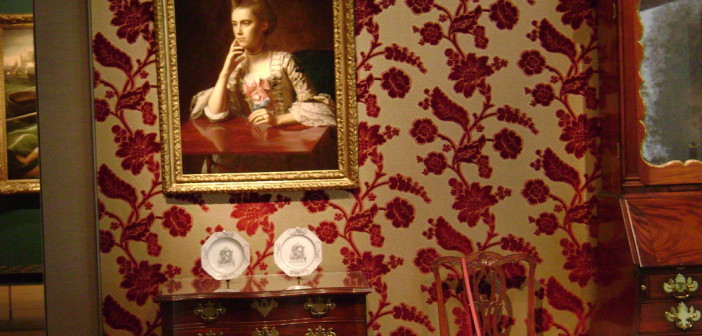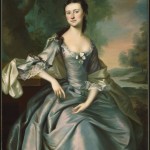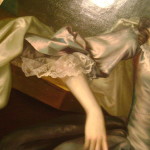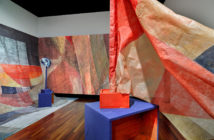Exploring identity in her modernist novel Orlando, Virginia Woolf suggests that people wish to be in a state "stilled, and become, what is called, rightly or wrongly, a single self, a real self."1 It is easy to see a traditional portrait as representing that "stilled . . . real self," especially when one moves away from a fragmented Picasso figure to eighteenth-century portraits, such as the Museum of Fine Arts’ collection. When the artist is John Singleton Copley, realistic faces meet our eyes with directness and warmth, and luxurious surroundings indicate an appealing material world. The style of these portraits offers a pleasurable sense of human contact, despite our knowing the sitters have long since departed. When an institution such as the National Portrait Gallery says its mission is "to tell the history of America through individuals who have shaped its culture," the idea of the portrait as stand-in for the actual person becomes concrete. I enjoy indulging this idea at the MFA, imagining a mystical connection with the patriot playwright Mercy Otis Warren; after all, her eyes meet mine every time. But I would like to discuss another way to understand these works: the portrait as a constructed self instead of only a record of self. The MFA incorporates this eighteenth-century idea of identity in its display, and challenges the impression that "real selves" are on view by presenting early American portraits as material and even theatrical objects.
The architecture writer Robert Campbell defines a building’s visual appeal as its "good hat" and "good face," as if it can engage and please passersby as a person might. In Cityscapes of Boston, he fills out this metaphor of building as person, mentioning its openings for ingress and egress, and orifices from which a mind may look out at the world. A building’s public identity is often the fixed exterior it presents, while its interior may be irrelevant, or at least invisible, to the viewer. His metaphor has a building mimic the organic body, but in the eighteenth century, the body, and indeed the entire "self," was as constructed as any building. People constructed themselves through clothes, literally and symbolically, and also through patterns of graceful and sociable behaviors. According to some scholars, these exterior aspects of a person were not some social mask placed over a true "inner" self. In fact, Dror Wahrman has argued that the eighteenth century did not even recognize an authentic inner self that we take for granted as the source of our "real" identity. He writes that identity was not "anchored in a deeply seated self," a concept not existing at the time, but in appearance and in clothes.2 Like clothing, identity could be changed, because your "look" did not reflect who you were, but rather constituted who you were. His idea supports American historian T. H. Breen’s claim that clothes mattered more in a portrait than the face or the pose, the nature of the fabric expressing more than any other element portrayed.3
Thus the clothing appeals not only because of our weakness for costume drama, but also because portraits were supposed to depict these visually stunning fashions in their full glory. As the MFA points out, some eighteenth-century artists were clothing specialists and painted only the flow and folds of garments, the way the light caught their rich colors and exquisite decoration. Standing before a portrait by Joseph Blackburn, visitors are asked to contrast the depictions of clothes and face, to consider whether Blackburn was one of these artists. Such a specialty reveals how important the beauty of the clothes was to portraits. In most examples in the MFA collection, the fabric takes up a great deal of the picture, is very eye-catching despite the direct gaze of the sitter, and is often more physically central to the painting than the sitter’s face.
Clothes "constructed" the sitter in a couple of ways. First, an eighteenth-century lady’s gown, with the monumental look of a statue carved from one block, was actually built out of several pieces. As Tamami Suoh of the Kyoto Costume Institute wrote, "Women’s dresses were not so much items of apparel as awesome architectural constructions made of fabric."4 A typical robe à la française, worn for much of the century, consisted of a corset, panniers on the hips to round out the lower fabric, a skirt-like petticoat, a robe that extended from collar to floor, and a triangular stomacher, which covered the torso in front where the robe was open. The built-up shape of these pieces created the size and appearance of the body. Even fabric itself had an architectural quality; ladders of ribbon, heavy embroidery, layers of lace, and the cotton-filled puffs of bouillonné gave clothes a three-dimensional aspect just as ornament does on a building’s façade. Looking at the powerful presence of clothing as it envelops both male and female sitters in eighteenth-century portraits, it makes sense to see clothes as we do the exterior of a building: the construction that makes identity without a hidden and perhaps irrelevant interior.
Aside from forming appearance and focusing the viewer on a person’s all-important exterior, clothing also signified identity in more symbolic ways to people who could read it. It was, like other possessions, playing its role in "a process of alluring self-presentation and elegant communication that was central to the formation of elite identities."5 Elaborate men’s or women’s clothing both restrained the body and also offered endless opportunity to be pleasingly graceful. With every gesture of a hand extending from a pond of lace or embroidered sleeve, with every change of pose, the wearer could make clothes move with a skill meant to "engage and delight." 6 Wearing such clothes in a portrait required social status and the wealth to afford it. The lovely drape of a painted garment also signified the ability and desire to adhere to elite standards of pleasing sociability. Without a concept of an immutable inner self, joining a social category through appearance and behavior was key to identity. As Wahrmann puts it, identity was "identicality rather than uniqueness, looking outward, toward what one shared . . . ."7 The warm and direct gaze I mentioned earlier, so engaging even to museum visitors, was not just a painting trend, but rather also signified what clothes did, a wish to please another. That sense of personality the eighteenth-century eyes offers today is not an "inner person" shining out of a skillful portrait, but rather a self constructed by the elements of that portrait, the elements those sitters understood as altogether constituting identity.
Other objects that appear in these portraits also serve as identity signs. In some cases, they are symbols of a man’s profession, such as the land he owns or the documents of his business. The painted objects can also enhance the sense of the sitter’s wealth or show his or her graceful interactions with them. It is interesting to note the MFA gallery’s description of John Singleton Copley as an established "painter of material things," adept at polished wood, the texture of satin, and the details of lace. It was a required talent for portraying people who lived in a world of objects they used for self-fashioning.
A portrait not only contained objects, but was also itself an object. The MFA invites visitors to view some portraits as part of an ensemble of objects, and to remember that paintings have their own material presence. Copley’s Mrs. Richard Skinner (Dorothy Wendell) of 1772 both contains objects and takes its place as one in the gallery. Mrs. Skinner is sitting at a polished table that reflects her image, tying her beautifully fashioned self to the beautifully fashioned furniture: both create her identity. Her prettily posed hand, in three layers of cuff lace, holds a delicate flower that is mirrored in the floral pattern of her English silk gown. The painting is full of graceful curves, those of her coiffed hair, her lovely face, her curled fingers, and the draping of her clothes. Below the portrait, the MFA has places a chest of drawers and a chair, the main qualities of which are fine material and curving lines. The chest’s edges, front, and legs all curve inward and outward, as do the back and legs of the chair. Not only does this small vignette tie the two objects to the contents of the painting, but it also connects the furniture with the painted surface itself, all objects in a refined, privileged eighteenth-century home.
The portrait-as-object is further emphasized by the gallery’s printed information, which explains that women often did not wear their own clothes, but rather something from the artist’s stock or imagination. Having the artist paint a sitter’s personal wardrobe was not necessarily a priority. Instead, the purpose was an image with the correct signs in place for identifying the sitter in the ways I have discussed. Often, Copley and other artists would not even create an "original" portrait for the sitter, but would copy the clothing and pose of English prints or earlier paintings. What today’s visitors might see as a unique painting of a specific individual could actually be closer to a mass-produced object. Portraits in this way conveyed status through their mere existence, as "not merely signs but acts of gentility."8 As one walks around the galleries, the impression also arises of a community of spirit and taste among these elite early Americans. It would have been, for much of the century, a community in cultural solidarity with England, the main source of material goods and fashions. They would also have shared an understanding of portraits "as wall furniture," things whose "meaning [was]largely within a context of other objects."9
Breen’s description of a portrait as part of the scenery of self-presentation suggests a theatrical, performative aspect of these portraits in the eighteenth century. If identity was constituted by one’s social performance, identity’s theatrical nature needed an appropriate set and props to support it. The way Breen’s "context of other objects" makes meaning is clear in the way the MFA displays the American eighteenth-century collections. As many museums now do, it creates a series of small vignettes. Paintings are displayed with furniture, silver, china, and other objects that would have shared a room in their owners’ homes. The effect of these little "scenes" is more striking after one sees portraits displayed only with other portraits. One gallery features the famous patriots Sam Adams, John Hancock, and Joseph Warren alone on a wall. Their fame, and their relation only to each other, removes any sense of looking into a room or into someone’s life. The viewer is a looking at Boston’s patriots in a gallery at the MFA, period. These paintings, despite all I have said here, feel like the official record of great men because of the way we are asked to view them. Their stature as People Who Should Be Immortalized is the primary impression this wall gives, and the portraits remain for posterity. It is respectful and appropriate for these sitters, but it also makes the motivation for preserving the sitters the primary thing one sees, despite their fine clothes, pleasant faces, and obvious membership in the community of taste.
Other portraits make a different impression because the vignettes invite us to glimpse a room in the eighteenth century, to use a panel of rich wallpaper behind a portrait and an empty chair to enter a dramatic scene. Here the objects take on the split personality that theater props and stage furniture have: they are present, material things but also signify things that are not real, not actually present. The wall on which a portrait hangs is part of the MFA gallery. But it also signifies a "wall" that is not there, the wall of a home where this portrait once hung, below which a chair and table like these stood, existing partly in the viewer’s imagination. Standing before them is like watching a play: the actor playing Hamlet can sit in a chair in the same space with the audience, but the character "Hamlet" also sits in a "chair" in a castle that does not really exist. Things take on the function of signs, signifying these other "rooms." The visitor gets two simultaneous messages: please do not touch the object in front of you and please consider a "chair" this object signifies, in a room that does not exist but looked like this. The MFA portraits are the same, tangible objects and "objects" that exist within theatrical presentation. Thus we can think of the curators creating this dual identity for the portraits in the same way the portraits created their sitters’ identities. Since portraits actually constitute constructed eighteenth-century selves, how fitting that the MFA allows the objects to exist in both a theatrically determined time and space as well as in the gallery with us. Despite the solidity of pictures around us, visitors can step into a fluid and fascinating vision.
- Joseph Blackburn, Susan Apthorp (Mrs. Thomas Bulfinch), Oil on Canvas, 1757.
- Sumptuous detail of the fabric in Susan Apthorp (Mrs. Thomas Bulfinch) by Joseph Blackburn
- The MFA’s installation of John Singleton Copley’s Mrs. Richard Skinner (Dorothy Wendell) (oil on canvas, 1772) in the Americas Wing
[1] Woolf, Virginia. Orlando. (San Diego/New York/London: Harcourt Brace and Company, n.d.) 314
[2] Wahrmann, Dror. The Making of the Modern Self: Identity and Culture in Eighteenth-Century England. (New Haven/London: Yale University Press, 2004.) 176
[3] Breen T. H. "The Meaning of ‘Likeness’: Portrait-Painting in an Eighteenth-Century Consumer Society" in The Portrait in Eighteenth-Century America. Ellen G. Miles, ed. (Newark: University of Delaware Press, 1993.) 39
[4] Suoh, Tamami. "18th Century". Fashion: A History from the 18th to the 20th Century. Vol. 1. (The Kyoto Costume Institute. Hong Kong: Taschen, 2002.) 29
[5] Hellman, Mimi. "Interior Motives: Seduction by Decoration in Eighteenth-Century France". Introduction. Dangerous Liaisons: Fashion and Furniture in Eighteenth-Century France. By Harold Koda and Andrew Bolton. (New York: The Metropolitan Museum of Art/New Haven: Yale University Press, 2004.) 15
[6] Hellman, Mimi. "Interior Motives: Seduction by Decoration in Eighteenth-Century France". Introduction. Dangerous Liaisons: Fashion and Furniture in Eighteenth-Century France. By Harold Koda and Andrew Bolton. (New York: The Metropolitan Museum of Art/New Haven: Yale University Press, 2004.) 17, 23
[7] Wahrmann, Dror. The Making of the Modern Self: Identity and Culture in Eighteenth-Century England. (New Haven/London: Yale University Press, 2004.) 85
[8] Gross, Robert A. "Gentlemen Prefer Swords: Style and Status in the Eighteenth-Century Portrait" in The Portrait in Eighteenth-Century America. Ellen G. Miles, ed. (Newark: University of Delaware Press, 1993.) 119
[9] Breen T. H. "The Meaning of ‘Likeness’: Portrait-Painting in an Eighteenth-Century Consumer Society" in The Portrait in Eighteenth-Century America. Ellen G. Miles, ed. (Newark: University of Delaware Press, 1993.) 48
Additional reference sources
Campbell, Robert and Peter Vanderwarker. Cityscapes of Boston: An American City Through Time. (Boston: Houghton Mifflin Company, 1992.)
Museum of Fine Arts, Boston. Gallery information, Art of the Americas Wing.
Smithsonian National Portrait Gallery: Donald W. Reynolds Center for American Art and Portraiture. National Portrait Gallery. Smithsonian Institution. n.d. Web. 2 Dec. 2012.







